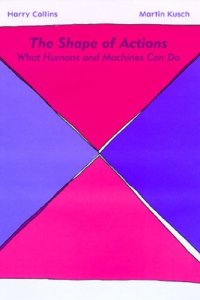
Ebook: The Shape of Actions: What Humans and Machines Can Do
Author: Harry M. Collins Martin Kusch
- Tags: Intelligence Semantics AI Machine Learning Computer Science Computers Technology Environmental Groundwater Flood Control Insecticides Pesticides Pollution Waste Management Water Quality Treatment Civil Engineering Transportation History Philosophy Math Aesthetics Analytic Consciousness Thought Criticism Eastern Epistemology Ethics Morality Free Will Determinism Good Evil Greek Roman Surveys Logic Language Medieval Metaphysics Methodology Modern Renaissance Movements Political Reference Religious
- Year: 1999
- Publisher: The MIT Press
- Language: English
- pdf
What can humans do? What can machines do? How do humans delegate actions to machines? In this book, Harry Collins and Martin Kusch combine insights from sociology and philosophy to provide a novel answer to these increasingly important questions.The authors begin by distinguishing between two basic types of intentional behavior, which they call polimorphic actions and mimeomorphic actions. Polimorphic actions (such as writing a love letter) are ones that community members expect to vary with social context. Mimeomorphic actions (such a swinging a golf club) do not vary. Although machines cannot act, they can mimic mimeomorphic actions. Mimeomorphic actions are thus the crucial link between what humans can do and what machines can do.
Following a presentation of their detailed categorization of actions, the authors apply their approach to a broad range of human-machine interactions and to learning. Key examples include bicycle riding and the many varieties of writing machines. They also show how their theory can be used to explain the operation of organizations such as restaurants and armies. Finally, they look at a historical case — the technological development of the air pump — applying their categorization of actions to the processes of mechanization and automation. Automation, they argue, can occur only where what we want to bring about can be brought about through mimeomorphic action.
Following a presentation of their detailed categorization of actions, the authors apply their approach to a broad range of human-machine interactions and to learning. Key examples include bicycle riding and the many varieties of writing machines. They also show how their theory can be used to explain the operation of organizations such as restaurants and armies. Finally, they look at a historical case — the technological development of the air pump — applying their categorization of actions to the processes of mechanization and automation. Automation, they argue, can occur only where what we want to bring about can be brought about through mimeomorphic action.
Download the book The Shape of Actions: What Humans and Machines Can Do for free or read online
Continue reading on any device:

Last viewed books
Related books
{related-news}
Comments (0)